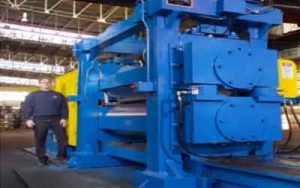A Roller mill is a form of compression mill that uses a single, double, or triple cylindrical heavy wheel mounted horizontally and rotated about their long axis either in opposing pairs or against flat plates, to crush or grind various materials.
One of the rollers is run by a motor and the others are rotated by friction as the material is drawn through the gap between the rollers.
This mill works on the principle of compression by applying stress. The Stress is applied by rotating heavy wheels or rollers.
The rollers rotate at different speeds and the material is sheared as it passes through the gap. Roller mills simply “roll” or “crush” products between two revolving cylinders.
There are many types of size-reduction equipment, which are often developed empirically to handle specific materials and then are applied in other situations.
Various factors like hardness, toughness, stickiness, slipperiness, moisture content, melting or softening point, abrasiveness and others (material structure, size, shape, flow, and bulk density of product) ratio of feed size to product size, affect the size reduction.
What are the Roller mills made of?
A roller mill is made up of two cylindrical rollers comprised of stone or metal where rollers have diameters ranging from a few mm to a meter. The rollers are made of cast iron, corrugated or grooved in various patterns.
A feed-filling mechanism provides the necessary force to allow the feed to pass through the first pair of rollers, either by the use of a small mill opening or a high rate of feed.

Rollers rotate on their longitudinal axis where one roller is subjected to a motor while the other runs freely. The size of the particle depends on the gap between the rollers.
The material is fed from the hopper into the gap between the rollers and the rollers are also allowed to rotate simultaneously.
Size reduction occurs when the feed passes through the rollers under high pressure. The product is then collected in the receiver at the bottom of the mill.
Types of Roller Mill
The design of a roller mill differs depending upon its application and they are usually named according to the work they perform.
Crackers – A mill used to crack grain or other types of brittle materials.
Flakers – Mills used to flake grains or other materials
Grinders (Roller mill grinders) – Roller mills that are used to grind in a feed mill.
Crimpers – Roller mills that crimp grains
Crimper – Crackers a roller mill that cracks and at the same time crimps grains.
Crumbler – A roller mill designed to break up pellets into smaller particles.
Two variants of roller mill are recognized and they are;
- Multiple or corrugated rollers
- Ribbed or saw-toothed rollers.
Advantages of Roller Mills
Here are a few positive aspect of using roller mills:
- Produce more uniform, fewer fines, and oversized particles when it comes to product quality.
- Generates less heat (0 – 3 0C) unlike hammer mill that generates up to 10 0C
- Less moisture loss
- Better work environment due to low machine noises level
- It is energy efficient/energy saving
- Reducing working hazards due to dust generation from the milling material.
- Require little or no airflow to operate effectively due to the fact that, with the rollers being mounted horizontally, the product passes through by gravity.
Disadvantages of Roller Mills
The disadvantages of using roller mills includes:
- Not effective on fiber or two-dimensional products. Works best on easy-to-grind materials like corn, cereal grains, etc.
- Additional operator inputs are required since the rolls need to be adjusted to suit grind requirements.
- when the roll chills become worn, replacing them with new chills and subsequently corrugating the old chills is a major endeavor in terms of time and expense. The good news, however, is there are no screens that can burst or become damaged.
Uses of roller mills
- It is used in the preparation of ointment; paste, creams, and other semi-solid preparations.
- Roller mills are used for crushing seeds prior to extraction.
- Roller mills are used in the cane-sugar industries. In this, trains of four or seven rollers are used. Crushing of the cane is carried between rollers, as the feed is introduced by an apron conveyor.
- It results in particle size 80-100 mesh
- Used for tough and fibrous material
- Size reduction of drugs extracted from medicinal plants and animal tissues
- It is also used for the production of rubber, and plastics and the recycling of paper
- In de-watering of paper, a two-roller mill is used, usually supported on a felt.
- A double roller mill is used to squeeze the water (or process liquid) in the final step of textiles. In dyeing, the cloth is thoroughly impregnated with small quantities of dye and is successively squeezed with pad rolls.
Conclusion
Roller mills use the process of stress (which is applied by the rotating wheels) and attrition in the milling solids in suspensions, pastes or ointments, and some solid materials.
The rollers rotate at different speeds and the material is sheared as it passes through the gap. To obtain the desired particles size, The gap between the rollers, The speed differential between the rolls, and the Feed rate should be controlled
